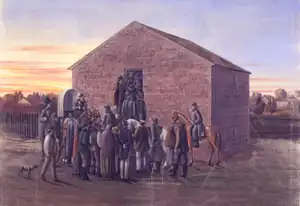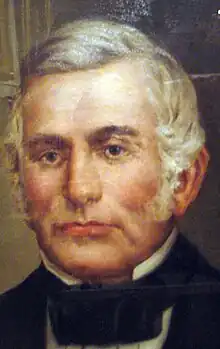
Missouri Executive Order 44 (known as the Mormon Extermination Order) was a state executive order issued by Missouri Governor Lilburn Boggs on October 27, 1838, in the aftermath of the Battle of Crooked River—a clash between members of the Church of Jesus Christ of Latter-day Saints and a unit of the state militia in northern Ray County during the 1838 Mormon War.[1]
Claiming that Mormons had committed open and avowed defiance of the law and had made war upon the people of Missouri, Governor Boggs directed that "the Mormons must be treated as enemies, and must be exterminated or driven from the State if necessary for the public peace—their outrages are beyond all description".[2]
The order was directed to General John Bullock Clark, and it was implemented by the state militia to forcefully displace the Mormons from their lands in Missouri. In response to the order, the Mormons surrendered and subsequently sought refuge in Nauvoo, Illinois.
The language of the order, particularly the use of the term "extermination," has been a subject of debate.[3] While the order authorized the use of force to remove the Mormons from Missouri, Boggs himself later clarified that he did not seek bloodshed or the annihilation of the Mormon population should they surrender.[4] In 1976, citing its unconstitutional nature, Missouri Governor Kit Bond formally rescinded it.
Text of the order
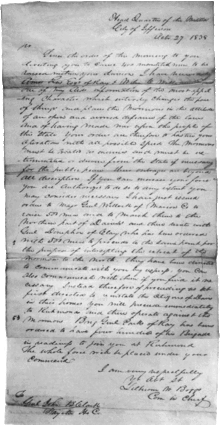
Missouri Executive Order Number 44 reads as follows:
Headquarters of the Militia,
City of Jefferson, Oct. 27, 1838.
Gen. John B. Clark:
Sir: Since the order of this morning to you, directing you to cause four hundred mounted men to be raised within your division, I have received by Amos Reese, Esq., of Ray county, and Wiley C. Williams, Esq., one of my aids [sic], information of the most appalling character, which entirely changes the face of things, and places the Mormons in the attitude of an open and avowed defiance of the laws, and of having made war upon the people of this state. Your orders are, therefore, to hasten your operation with all possible speed. The Mormons must be treated as enemies, and must be exterminated or driven from the state if necessary for the public peace—their outrages are beyond all description. If you can increase your force, you are authorized to do so to any extent you may consider necessary. I have just issued orders to Maj. Gen. Willock, of Marion county, to raise five hundred men, and to march them to the northern part of Daviess, and there unite with Gen. Doniphan, of Clay, who has been ordered with five hundred men to proceed to the same point for the purpose of intercepting the retreat of the Mormons to the north. They have been directed to communicate with you by express, you can also communicate with them if you find it necessary. Instead therefore of proceeding as at first directed to reinstate the citizens of Daviess in their homes, you will proceed immediately to Richmond and then operate against the Mormons. Brig. Gen. Parks of Ray, has been ordered to have four hundred of his brigade in readiness to join you at Richmond. The whole force will be placed under your command.
I am very respectfully,
yr obt st [your obedient servant],
L. W. Boggs,
Commander-in-Chief.[2]
Background
Executive Order 44 was issued during the 1838 Mormon War, which was caused by friction between members of the Church of Jesus Christ of Latter-day Saints and their neighbors due to the economic and electoral growth of the Latter-day Saint community.[5]The religious and political views of Church members did not sit well with the non-Mormon citizens of the state. Tensions had been steadily rising due to 1833 newspaper articles written in Independence, Missouri, which culminated in a manifesto published by many Missouri public officials:
We, the undersigned, citizens Jackson County, believing that an important crisis is at hand, as regards our civil society, in consequence of a pretended religious sect of people that have settled, and are still settling in our County, styling themselves Mormons; and intending, as we do, to rid our society, "peaceably if we can, forcibly if we must," and believing as we do, that the arm of the civil law does not afford us a guarantee, or at least a sufficient one against the evils which are now inflicted upon us, and seem to be increasing, by the said religious sect, deem it expedient, and of the highest importance, to form ourselves into a company for the better and easier accomplishment of our purpose—a purpose which we deem it almost superfluous to say, is justified as well by the law of nature, as by the law of self-preservation.
It is more than two years since the first of these fanatics, or knaves, (for one or the other they undoubtedly are) made their first appearance among us, and pretended as they did, and now do, to hold personal communication and converse face-to-face with the Most High God; to receive communications and revelations direct from heaven; to heal the sick by laying on hands; and, in short, to perform all the wonder-working miracles wrought by the inspired Apostles and Prophets of old.
We believed them deluded fanatics, or weak and designing knaves, and that they and their pretensions would soon pass away; but in this we were deceived. The arts of a few designing leaders amongst them have thus far succeeded in holding to them together as a society; and since the arrival of the first of them, they have been daily increasing in numbers; and if they had been respectable citizens in society and thus deluded they would have been entitled to our pity rather than to our contempt and hatred; but from their appearance, from their manners, and from their conduct since their coming among us, we have every reason to fear that, with but very few exceptions, they were of the very dregs of that society from which they came, lazy, idle, and vicious. This we can see it is not idle assertion, they fact susceptible of proof, or with these few exceptions above-named, they brought into our country little or no property with them and left less behind them, and we infer that those only yoked themselves to the "Mormon" car who had nothing earthly or heavenly to lose by the monad; and we fear that if some of the leaders amongst them, had paid the forfeit due to crime, instead of being chosen ambassadors of the Most High, they would have been inmates of solitary cells. But their conduct here stamps their characters in their true colors. More than a year since, it was ascertained that they had been tampering with our slaves, and endeavoring to sow dissensions and raise seditions amongst them. Of this their "Mormon" leaders were informed, and they said they would deal with any of their members who should again in like case offend. But how spacious are appearances. In a late number of the Star, published in Independence by the leaders of the sect, there is an article inviting free Negroes and mulattoes from other states to become "Mormons," and remove and settle among us. This exhibits them in still more odious colors. It manifests a desire on the part of their society, to inflict on our society an injury that they know would be to us entirely insupportable, and one of the surest means of driving us from the country; for it would require none of the supernatural gifts that they pretend to, to see that the introduction of such a caste among us would corrupt our blacks, and instigate them to bloodshed.
They openly blaspheme the Most High God, and cast contempt on His holy religion, by pretending to receive revelations direct from heaven, by pretending to speak unknown tongues, by direct inspiration, and by diverse pretenses derogatory to God and religion, and to the utter subversion of human reason.
They declare openly that their God hath given them this county of land, and that sooner or later they must and will have possession of our lands for inheritance; and, in fine, they have conducted themselves on many other occasions, and such a manner, that we believe it a duty we owe to ourselves, our wives, and children, to the cause of public morals, to remove them from among us, as we are not prepared to give up our pleasant places and goodly possessions to them or to receive into the bosom of our families, as fit companions for wives and daughters, the degraded and corrupted free Negroes and mulattos that are now invited to settle among us.
Under such a state of things, even our beautiful county would cease to be a desirable residence, and our situation intolerable! We, therefore agree (that after timely warning, and receiving an adequate compensation for what little property they cannot take with them, they refuse to leave us in peace, as they found us—we agree to use such means as may be sufficient to remove them, and to that and we each pledge to each other our bodily powers, our lives, fortunes and sacred honors.
We will meet at the courthouse, at the town of Independence, on Saturday next, the 20th inst., [July], to consult on subsequent movements.
Among the hundreds of names attached to the document were:
Louis Franklin, jailer
Samuel C. Owens, County Clerk
Russel Hicks, Deputy County Clerk
R.W. Cummins, Indian agent
James H. Flournoy, Postmaster
S.D. Lucas, Colonel and judge of the court
Henry Chiles, attorney-at-law
N.K. Olmstead, M.D.
John Smith, justice in peace
Samuel Westin, justice of the peace
William Brown, Constable
Abner F. Staples, Captain
Thomas Pitcher, Deputy Constable
Moses G. Wilson and Thomas Wilson, merchants[6]
On the same day, July 20, 1833, the W. W. Phelps printing press, which published the Evening and the Morning Star in Independence, was destroyed by a mob.
The destruction was also in retaliation for the publication of portions of the Joseph Smith Translation of the Bible, particularly that of the book of Genesis, in the Evening and the Morning Star in August 1832 and in March and April 1833.[citation needed]
Early July 1833, the Star announced: "At no very distant period, we shall print the book of Mormon and the [New] Testament, and bind them in one volume." However, hopes for this were postponed when the printing press in Independence was destroyed.
The 1838 Mormon War ended with the expulsion of nearly all members of the Church of Jesus Christ of Latter-day Saints from the state of Missouri.[7]
Executive Order 44 is often referred to as the "Extermination Order" due to the phrasing used by Governor Boggs.

The relationship between the Mormons and the state of Missouri had its roots in 1830, when a group of missionaries were sent to western Missouri with the goal of proselytizing among the Native Americans. This group arrived in Jackson County, Missouri, and initially encountered a welcoming response from some residents who were receptive to their message.[8]
In summer of 1831, Jackson County was designated as the place of Zion—a sacred site where Mormons believed they would gather and prepare for the Second Coming of Jesus Christ. However, as the number of Mormons in the area grew, tensions emerged between the Mormons and their non-Mormon neighbors. This was partly due to the religious and cultural differences between the two groups, economic competition, political differences, and fears of cultural displacement.[1][9]
Tensions had been steadily rising and reached a boiling point in summer of 1833, when two newspaper articles discussing Missouri laws concerning slavery were published by the Mormon newspaper, the Evening and the Morning Star in Independence, Missouri. These articles were interpreted by Missourians as inviting free blacks to settle in the county.[10] Residents of Jackson County, including several public officials, published a manifesto accusing the Mormons of having a "corrupting influence" on their slaves, and calling for their removal: "peaceably if we can, forcibly if we must."[11] On the same day, July 20, 1833, the W. W. Phelps printing press, which published the newspaper in Independence, was destroyed by a mob.[12]
Mormons were given a county of their own —Caldwell County— in 1836, following their expulsion from Jackson County in 1833. However, the increasing influx of new converts moving to northwestern Missouri led them to begin settling in adjacent counties. Other settlers, who had operated under the assumption that Mormons would remain confined to Caldwell County, became angry due to these new settlements.[10]
On July 4, 1838, First Presidency member Sidney Rigdon delivered an oration in Far West, the county seat of Caldwell County. Rigdon wanted to make clear that Mormons would meet any attacks on them with force. Far from settling tensions, Rigdon's oration had the opposite effect: it terrified and inflamed the residents of surrounding counties. By the fall of that same year these tensions escalated into open conflict, culminating in the looting and burning of several Mormon farms and homes, the sacking and burning of Gallatin by the Danites, and the taking of Mormon hostages by Captain Samuel Bogart and his state militia unit, operating in northern Ray County (to the south of Caldwell).[13]
A Mormon armed group from the town of Far West moved south to the militia camp on the Crooked River in order to rescue the hostages, causing rumors of a planned full-scale invasion of Missouri that ran rampant throughout the summer and aroused terror throughout the western part of the state. These rumors only increased as reports of the Battle of Crooked River reached the capital at Jefferson City, with exaggerated accounts of Mormons supposedly slaughtering Bogart's militia company, including those who had surrendered.[11] Further dispatches spoke of an impending attack on Richmond, county seat of Ray County, though in fact no such attack was ever contemplated.[14]
Previously, Governor Boggs had received word that Mormons had driven several citizens of Daviess County (north of Caldwell) from their homes. He had then appointed General John Bullock Clark to lead the State Militia in assisting those citizens to return. But after hearing these reports, Governor Boggs issued new orders directing Clark to commence direct military operations and issued Missouri Executive Order 44.[8][15][16]
Human and economic losses
Displacement

General Clark cited Executive Order 44 soon after the Mormon settlers surrendered in November 1838, saying that violence would have been used had they chosen not to surrender.[17] General Clark explicitly stated that the Mormons should expect no mercy and that their leaders would not be returned to them. Clark furthermore stated:
I do not say you shall go now, but you must not think of staying here another season, or of putting in crops, for the moment you do this, the citizens will be upon you; and if I am called here again, in a case of a non-compliance of a treaty made, do not think I will do as I have now. You need not expect any mercy, but extermination, for I am determined the governor's orders be executed. As for your leaders, do not think, do not imagine for a moment, do not let it enter into your mind, that they will be delivered and restored to you again, for their fate is fixed, their die is cast, their doom is sealed.
Given recent activities involving other members of the state militia, the Mormons had valid reasons to take these threats seriously. Consequently, approximately 15,000 Mormons promptly fled to Illinois, enduring the harsh winter conditions.
Extermination
While the term extermination was used in the order, today it is widely understood that Boggs did not intend the physical annihilation of the Mormon population.[18] Boggs would claim later in his life that his main desire was to subdue the Mormons without bloodshed.[4] Scholars such as Alexander L. Baugh and Steven LeSueur suggest the word 'exterminate' reflects the historical usage of the term, which more broadly encompassed the expulsion or removal of a group or population from an area.[3][19]
Deaths
The question of whether anyone was directly killed as a result of the Extermination Order between its issuance on October 27, 1838, and the Latter-day Saint surrender on November 1, 1838, has been a subject of intense historical debate. The prevailing consensus among scholars is that there is limited evidence to suggest that militiamen invoked the order to justify their actions during that period.[19][4]
Haun's Mill
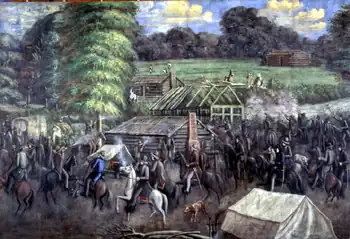
Many people connect Governor Boggs' order directly to the Haun's Mill massacre on October 30, 1838. At least one firsthand account asserts local Guardsmen referred to an order issued by the governor that sounds similar to Order 44 as justification for the Haun's Mill massacre.
The Haun's Mill massacre was launched by Missouri State Guardsmen from Livingston County on the settlement of Haun's Mill, located in eastern Caldwell County near the Livingston County line, which resulted in the deaths of 18 men and boys, some of whom were murdered after surrendering.[20]
Others state there is no evidence that the militiamen knew of the Executive Order, and participants in this massacre who spoke of it later never used Governor Boggs' decree to justify their actions.[7][4]
However, the firsthand account explains soldiers stated the governor had ordered their expulsion or extermination if they did not leave at once.[20]
"Halt!" commanded the leader of a band of well-mounted and well-armed mobocrats, who charged down upon them as they journeyed on their way.
"If you proceed any farther west," said the captain, "you will be instantly shot."
"Wherefore?" inquired the pilgrims.
"You are d__d Mormons!"
"We are law-abiding Americans, and have given no cause of offence."
"You are d__d Mormons. That's offence enough. Within ten days every Mormon must be out of Missouri, or men, women, and children will be shot down indiscriminately. No mercy will be shown. It is the order of the Governor that you should all be exterminated; and by God you will be."
Financial losses
To date, there have been no reparations or other financial compensation for losses by either side in the conflict. Historian William Alexander Linn wrote:
What the total of the pecuniary losses of the members of the Church of Jesus Christ of Latter-day Saints in Missouri was cannot be accurately estimated. They asserted that in Jackson County alone, $120,000 worth of their property was destroyed, and that fifteen thousand of their number fled from the state. Smith, in a statement of his losses made after his arrival in Illinois, placed them at $1,000,000. In a memorial presented to Congress at this time the losses in Jackson County were placed at $175,000, and in the state of Missouri at $2,000,000. The efforts of the Church of Jesus Christ of Latter-day Saints to secure redress were long continued. Not only was Congress appealed to, but legislatures of other states were urged to petition in their behalf. The Senate committee at Washington reported that the matter was entirely within the jurisdiction of the state of Missouri. One of the latest appeals was addressed by Smith at Nauvoo in December, 1843, to his native state, Vermont, calling on the Green Mountain boys, not only to assist him in attaining justice in Missouri, but also to humble and chastise or abase her for the disgraces she has brought upon constitutional liberty, until she atones for her sin.[17]
To put the dollar numbers in modern context: $1,000,000 in 1838 equals $31,913,655.91 in 2023.
Aftermath
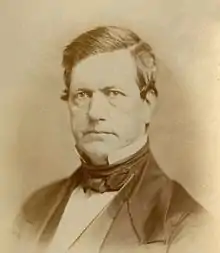
Although the Church leaders surrendered at Far West on November 1, members of the Church of Jesus Christ of Latter-day Saints (especially in outlying areas) continued to be subject to harassment and even forced ejection by citizens and militia units. The Church members in Caldwell County, as part of their surrender agreement, signed over all of their property to pay the expenses of the campaign against them; although this act was later held unlawful,[21] it became clear to them that departure from the state was the only option state officials were going to allow.
Upon his arrival at Far West, General Clark delivered the following speech to the now-captive Church members, in which he directly invoked Order 44:
...The order of the governor was to me, that you should be exterminated, and not allowed to remain in the state; and had not your leaders been given up, and the terms of this treaty [22] complied with, your families before this time would have been destroyed, and your houses in ashes. There is a discretionary power vested in my hands, which concerning your circumstances I will exercise for a season...[23][24]
Though Clark had offered to allow the Church members to remain in Missouri until the following spring, they decided to leave right away; according to one account, most had departed within ten days of Clark's speech.[23] Although Governor Boggs belatedly ordered a militia unit under Colonel Sterling Price (later to achieve fame as a Confederate Civil War general) to northern Missouri to stop ongoing depredations against the Mormons, he refused to repeal the order.[25] The Missouri legislature deferred discussion of an appeal by Church leaders to rescind the decree. Nearly all of the approximately 15,000 Mormons left Missouri by the spring of 1839, and would not begin to return to Missouri until approximately 25 years later.
Governor Boggs himself was excoriated in Mormon portions of the Missouri press, as well as those of neighboring states, for his action in issuing this order.[21] General David Atchison, a legislator and militia general from western Missouri who had refused to take part in operations, demanded that the Legislature formally state its opinion of Governor Boggs' order, for "he would not live in any state, where such authority was given".[26] Although his proposal and similar ones by others went down to defeat, Governor Boggs himself saw his once-promising political career destroyed to the point that, by the next election, his own party was reluctant to be associated with him.[27] After surviving an assassination attempt in 1842, Governor Boggs ultimately emigrated to California, where he died in relative obscurity in the Napa Valley in 1860.[27]
Rescission

In late 1975, President Lyman F. Edwards of the Far West stake of the Reorganized Church of Jesus Christ of Latter Day Saints, invited then Missouri Governor Kit Bond to participate in the June 25, 1976, stake's annual conference as a good-will gesture for the United States Bicentennial.[28] As part of his address at that conference, 137 years after being signed and citing the unconstitutional nature of Governor Boggs' directive, Governor Bond presented the following Executive Order:[29]
WHEREAS, on October 27, 1838, the Governor of the State of Missouri, Lilburn W. Boggs, signed an order calling for the extermination or expulsion of Mormons from the State of Missouri; and
WHEREAS, Governor Boggs' order clearly contravened the rights to life, liberty, property and religious freedom as guaranteed by the Constitution of the United States, as well as the Constitution of the State of Missouri; and
WHEREAS, in this bicentennial year as we reflect on our nation's heritage, the exercise of religious freedom is without question one of the basic tenets of our free democratic republic;
Now, THEREFORE, I, CHRISTOPHER S. BOND, Governor of the State of Missouri, by virtue of the authority vested in me by the Constitution and the laws of the State of Missouri, do hereby order as follows:
Expressing on behalf of all Missourians our deep regret for the injustice and undue suffering which was caused by the 1838 order, I hereby rescind Executive Order Number 44, dated October 27, 1838, issued by Governor Lilburn W. Boggs.
In witness I have hereunto set my hand and caused to be affixed the great seal of the State of Missouri, in the city of Jefferson, on this 25 day of June, 1976.
(Signed) Christopher S. Bond, Governor.[30]
See also
- Latter Day Saint martyrs
- Mormon Exodus (1846–1857)
- Pogrom
Notes
- 1 2 DeVoto 2000, pp. 84–85
- 1 2 Greene 1839, pp. 8, 26
- 1 2 Pokin, Steve. "Pokin Around: Was there ever a time in Missouri when you could legally kill a Mormon?". Springfield News-Leader. Retrieved November 8, 2023.
In 1838 parlance, Lawson says, the word "exterminate" primarily meant to "force to leave an area."
- 1 2 3 4 LeSueur 1987, pp. 163–164
- ↑ DeVoto, Bernard (2000) [1943]. The Year of Decision 1846. New York City: St. Martin's Griffin. pp. 82–86. ISBN 0312267940.
- ↑ Joseph Smith, History of the Church|1833, vol. 1, pp. 374–376
- 1 2 Hartley 2001, pp. 6, 20–23
- 1 2 Allen & Leonard 1992, pp. 136–138
- ↑ LeSueur 1987, p. 3
- 1 2 Alexander W. Doniphan, quote.
- 1 2 LeSueur 1987, pp. 143–144
- ↑ "Terror In Jackson County | Religious Studies Center". rsc.byu.edu. Retrieved November 7, 2023.
- ↑ "Battle of Crooked River | Ray County Museum". Retrieved November 7, 2023.
Bogart and his party began visiting the homes of Latter Day Saints living in Bunkham's Strip, forcibly disarming them and ordering them to leave Ray County. Bogart then penetrated into Caldwell County and began to similarly harass Mormons there, advising them to remove to Far West, the county seat. Returning to Ray County, his men captured three Mormons - Nathan Pinkham, Jr., William Seely, and Addison Green.
- ↑ LeSueur 1987, p. 150
- ↑ Quinn 1994, p. 100
- ↑ Office of the Secretary of State of Missouri 1841, pp. 50–63
- 1 2 Linn 2010, p. 121
- ↑ Whitman, Dale A. "Extermination Order". LDSFAQ. BYU Studies. Archived from the original on October 20, 2006. Retrieved February 4, 2007.
- 1 2 Baugh, Alexander (January 1, 2009). "The Haun's Mill Massacre and the Extermination Order of Missouri Governor Lilburn W. Boggs". Faculty Publications.
- 1 2 Tullidge 1877, p. 177
- 1 2 LeSueur 1987, pp. 225, 229, 237–238
- ↑ This refers to an agreement between the Mormons leaders and General Samuel Lucas, signed under duress, which compelled the Mormons to give up their leaders, their arms and all of their lands and property, and to then leave Missouri. General Clark's Speech, p. 1.
- 1 2 Lin 1987
- ↑ General Clark's Speech, p. 1.
- ↑ LeSueur 1987, pp. 232–233
- ↑ LeSueur 1987, p. 226
- 1 2 LeSueur 1987, pp. 258–259
- ↑ "The Extermination Order and How it was Rescinded". John Whitmer Historical Association. Archived from the original on May 26, 2011.
- ↑ Whitman, Dale A. "Extermination Order". LDSFAQ. BYU Studies. Archived from the original on October 20, 2006. Retrieved February 4, 2007.
- ↑ "Governor Bond's Rescission order" (PDF). The Missouri Mormon War collection. Missouri State Archives.
References
- Allen, James B; Leonard, Glen M (1992). The Story of the Latter-day Saints. Salt Lake City: Deseret Book Company. ISBN 087579565X.
- Anderson, Richard L (1994). "Clarification of Boggs' 'Order' and Joseph Smith's Constitutionalism". In Garr, Arnold K.; Johnson, Clark V. (eds.). Regional Studies in latter-day Saint History: Missouri. Provo, Utah: Department of Church History and Doctrine, Brigham Young University. pp. 27–43. ISBN 0842523197.
- Arrington, Leonard J.; Bitton, Davis (1979). The Mormon Experience: A History of the Latter-day Saints. New York City: Alfred A. Knopf. ISBN 0394465660.
- Britton, Roland J. (1920). "Early Days on Grand River and the Mormon War (4th article)". Missouri Historical Review. State Historical Society of Missouri. 16 (1).
- Bushman, Richard L (2007). Joseph Smith: Rough Stone Rolling. New York City: Vantage. ISBN 978-1400077533.
- LDS Church (2003). Church History in the Fulness of Times, Student Manual, Religion 341 through 343. Salt Lake City: Institute of Religion, Church Educational System, LDS Church. ISBN 978-1465118288. Archived from the original on May 22, 2012.
- Davis, Inez Smith (1948) [1934]. "Far West". The Story of the Church (4th rev ed.). Independence, MO: Herald Publishing House. LCCN 48002868. OCLC 4342028.
- DeVoto, Bernard (2000) [1943]. The Year of Decision 1846. New York City: St. Martin's Griffin. pp. 82–86. ISBN 0312267940.
- Furniss, Norman F (1966) [1960]. The Mormon conflict, 1850–1859. New Haven, CT: Yale University Press. LCCN 77005424. OCLC 32898643.
- Gentry, Leland H (1974). "The Danite Band of 1838". BYU Studies. Provo, Utah: Brigham Young University. 14 (4): 421–450.
- Greene, John P (1839). Facts Relative to the Expulsion of the Mormons or Latter Day Saints, from the State of Missouri, under the "Exterminating Order". Cincinnati, Ohio: R. P. Brooks. OCLC 4968992.
- Hartley, William G (2001). "Missouri's 1838 Extermination Order and the Mormons' Forced Removal to Illinois" (PDF). Mormon Historical Studies. 2 (1): 5–27.
- Jenkins, James H. (2014) [1999]. Casus Belli: Ten Factors That Contributed to the Outbreak of the 1838 'Mormon War' in Missouri (self-published) (2nd ed.). Charleston, South Carolina: CreateSpace. ISBN 978-1499514636. OCLC 44714508.
- Johnson, Clark V (1992). Mormon Redress Petitions: Documents of the 1833–1838 Missouri Conflict. Bookcraft. ISBN 0884948501.
- LeSueur, Stephen C. (1987). The 1838 Mormon War In Missouri. Columbia, MO: University of Missouri Press. ISBN 0826207294.
- Office of the Secretary of State of Missouri (1841), Document containing the correspondence, orders, &c., in relation to the disturbances with the Mormons; and the evidence given before the Hon. Austin A. King, judge of the Fifth judicial circuit of the state of Missouri, at the Court-house in Richmond, in a criminal court of inquiry, begun November 12, 1838, on the trial of Joseph Smith, and others, for high treason and other crimes against the state., Fayette, Missouri: Printed at the Office of the Boon's Lick Democrat, OCLC 7835420.
- Quinn, D. Michael (1994). The Mormon Hierarchy: Origins of Power. Salt Lake City: Signature Books. ISBN 1560850566.
- Rigdon, Sidney (1838), Oration delivered by Mr. S. Rigdon, on the 4th of July, 1838 at Far West, Caldwell County, Missouri, Far West, Missouri: The Journal Office, OCLC 80327335.
- Roberts, Brigham H (1900). The Missouri Persecutions.
- Roberts, B. H. (1900). The Missouri Persecutions. Salt Lake City: George Q. Cannon & Sons. LCCN 66000948. OCLC 6136459.
- Roberts, B. H. (1930). Comprehensive History of the Church of Jesus Christ of Latter-day Saints: Century I (Volume 1). Salt Lake City: Deseret News Press. LCCN 30024609. OCLC 3366367.
- Smith, Joseph (1948). History of the Church of Jesus Christ of Latter-day Saints. Vol. 3. Salt Lake City: Deseret Book Company.
- Smith, Joseph; Rigdon, Sidney; Smith, Hyrum (1840), An appeal to the American people: being an account of the persecutions of the Church of Latter Day Saints, and of the barbarities inflicted on them by the inhabitants of the state of Missouri, Cincinnati, Oh: Shepard and Stearns, T, New York, 1877, p. 117
- Tullidge, Edward W. (1877). The Women of Mormondom. New York City: Platt & Peters.
- Turner, J B (1842). Mormonism in All Ages; or the Rise, Progress and Causes of Mormonism; with the Biography of Its Author and Founder, Joseph Smith, Jr. New York City: Platt & Peters.
- Van Wagoner, Richard S. (1994). Sidney Rigdon: A Portrait of Religious Excess. Salt Lake City: Signature Books. ISBN 978-1560851974.
- Linn, William Alexander (2010). The Story of the Mormons from the Date of Their Origin to the Year 1901. New York: Kessinger. p. 121. ISBN 978-1162709543.
Further reading
- Linn, William Alexander (1901). "Book III, Chapter VIII: A State of Civil War". The Story of the Mormons: From the Date of their Origin to the Year 1901. New York: Macmillan. pp. 200–207. OCLC 621583.
External links
- Mormon War Letters, the battle correspondence leading up to, and including, the Extermination Order – presented by LDS historian Mel Tungate.
- The Missouri Mormon War Executive Orders include both the original Executive Order 44 and the rescinding order as PDFs – presented by the Missouri Secretary of State.
- Lilburn W. Boggs letter to Joseph Hawkins, Vault MSS 724, L. Tom Perry Special Collections, Harold B. Lee Library, Brigham Young University
